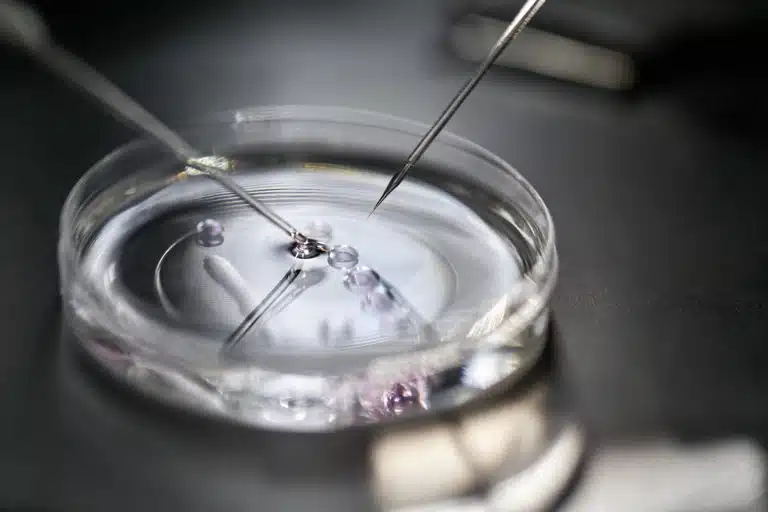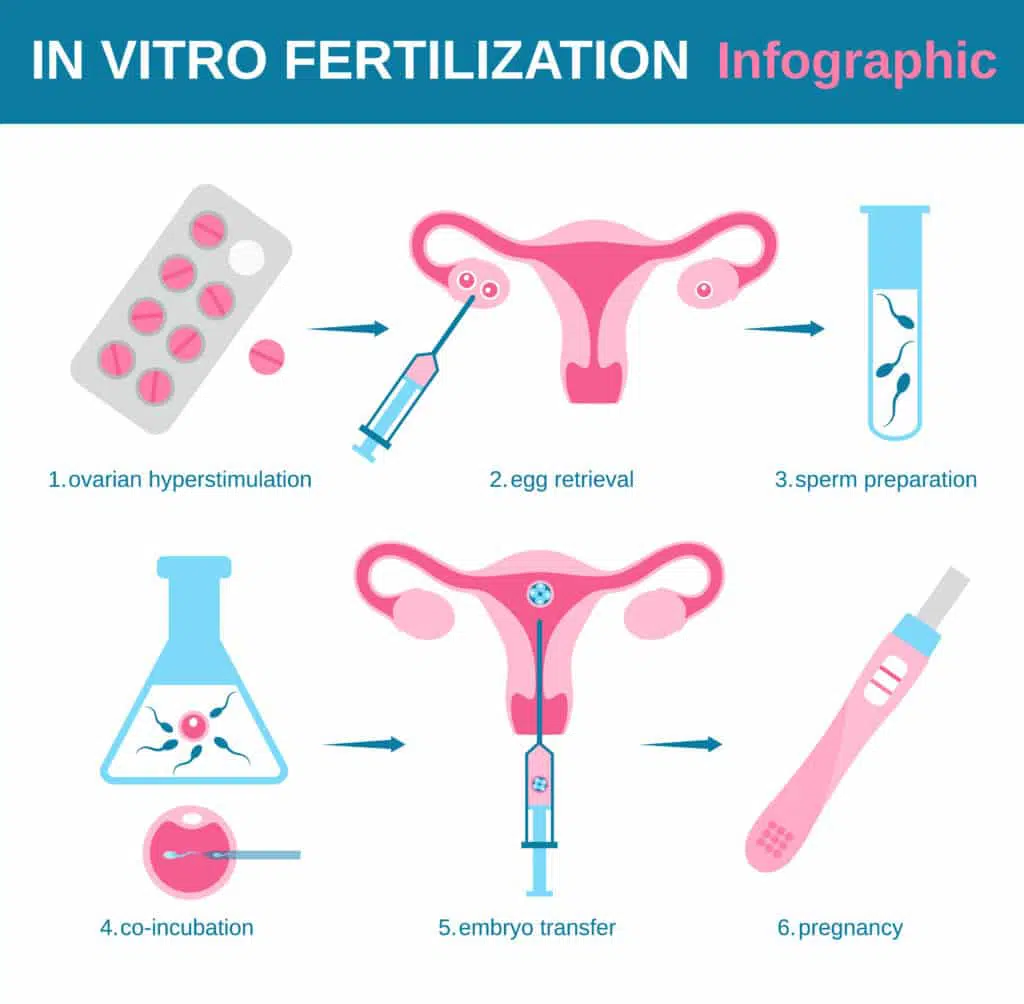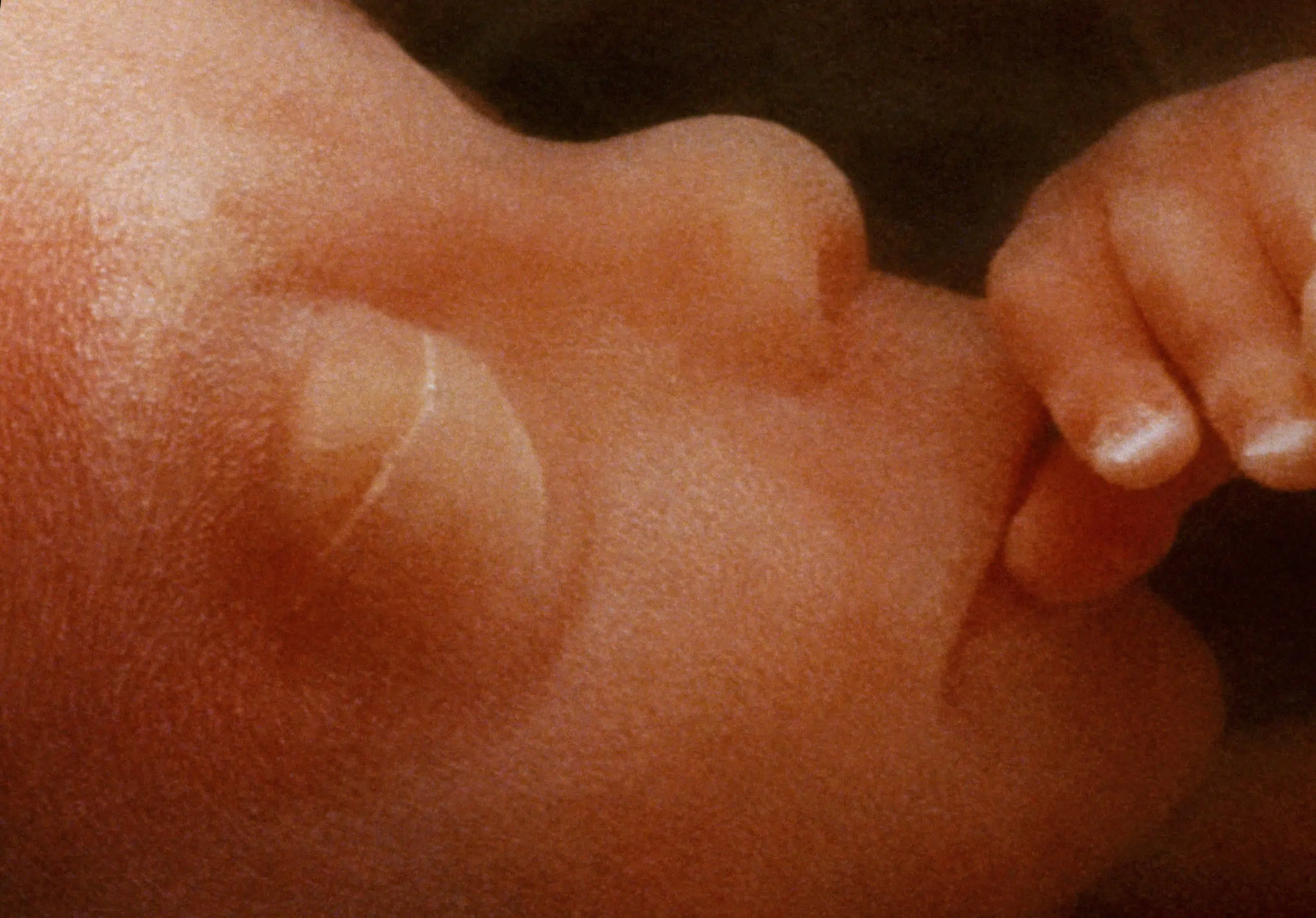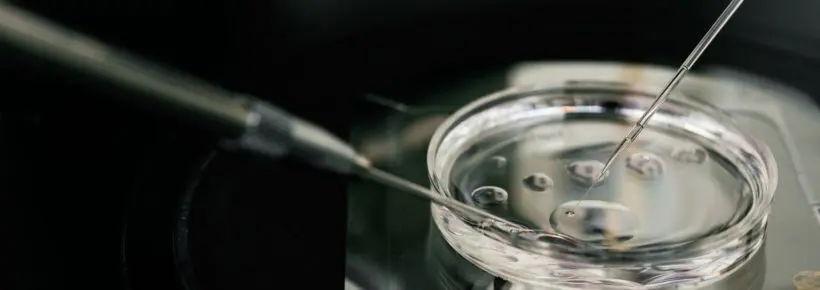The Centers for Disease Control (CDCs) define the general class of “assisted reproductive technologies” (ARTs) as those procedures where eggs or embryos are handled. This involves surgically removing eggs from a woman’s body, combining them with sperm in the laboratory, and then returning them to the woman (or another woman). The CDCs do not keep track of procedures where only the sperm is handled, such as intrauterine insemination (IUI) or procedures where the gametes are not removed from the body.1 The vast majority of all such ARTs consist of the simplest and longest-used procedure, in vitro fertilization (IVF).
The first IVF procedure was performed by Doctor Robert Edwards and abortionist Patrick Steptoe in 1977 and resulted in the birth of Louise Brown. This success was preceded by more than 200 failures and was financed primarily by revenues from abortions.2
There are many profound ethical issues involved with the use of IVF and other ARTs. These include:
- The damage done to the marriage bond
- The objectification of children
- The many human embryos killed or discarded during the process
- Even if a successful pregnancy is achieved, there are often too many embryos in the opinion of the doctors, and so many women resort to “pregnancy reduction” abortions.
The Underlying Issue: Is There a “Right to a Child”?
The general attitude among reproductive technology professionals is that there is a fundamental human right to have a child. ART technicians absolve themselves of any moral consideration by deeming themselves mere instruments whose job is to fulfill the human desire for a child.
Unfortunately, this attitude reduces the child to a mere possession that can be acquired at will. Donum Vitae says that this is:
…contrary to the child’s dignity and nature. The child is not an object to which one has a right, nor can he be considered as an object of ownership: rather, a child is a gift, “the supreme gift” and the most gratuitous gift of marriage and is a living testimony of the mutual giving of his parents. For this reason, the child has the right to be the fruit of the specific act of the conjugal love of his parents; and he also has the right to be respected as a person from the moment of his conception. (II,8)
In order to clarify the teachings of the Catholic Church on assisted reproductive technologies in general, we again turn to Donum Vitae, which teaches:
These interventions are not to be rejected on the grounds that they are artificial. As such, they bear witness to the possibilities of the art of medicine. But they must be given a moral evaluation in reference to the dignity of the human person, who is called to realize his vocation from God to the gift of love and the gift of life. (Introduction, 3. Emphasis added)
But What About the Infertile Couple?
In considering infertile couples who want nothing more than to have a child, their situation is heartbreaking to say the least. Naturally, many want to give such couples the chance to conceive, and thus they may see IVF as a mercy towards them – or as a miracle cure. Many try to claim that the Catholic Church is overly strict in its condemnation of practices like IVF. Many feel that it is cruel of the Church to ban certain methods of conception, especially in the case of infertility.
The Church understands and feels the pain of the infertile couple. Indeed, many Catholics are infertile, and they understand the heartbreak, frustration, trauma and confusion that it brings. Even in the most difficult times, the Church cannot allow its members to act in a way that compromises the dignity of the human person (such as is the case with the treatment of embryos in IVF) or that violates the conjugal act, which is a beautiful and dignified gift of marriage.
Children are gifts from God, not objects to be owned:
A child is not something owed to one, but is a gift. The “supreme gift of marriage” is a human person. A child may not be considered a piece of property, an idea to which an alleged “right to a child” would lead. In this area, only the child possesses genuine rights: the right “to be the fruit of the specific act of the conjugal love of his parents” and “the right to be respected as a person from the moment of his conception.” (CCC 2378, emphasis in original)
The Church would rejoice if, one day, infertility was completely cured. But it cannot compromise on the rights of the human person, nor on the dignity of and rights within marriage.
In Vitro Fertilization: Ethical Issues
Many may feel that the Catholic Church is randomly banning artificial methods to become pregnant, causing people to suffer infertility. We must point out that the teachings of the Church are always supported not only by theology, but also by science.
So, we may rightfully ask: “How do we determine if one of the dozens of different ART procedures is licit or not? What are the guidelines?”

In vitro fertilization
Catholic Sources on Infertility Treatments
Once again, Donum Vitae comes to the rescue. The document provides us specific and unambiguous guidelines designed to safeguard against abuses in the field of ART that commodify and dispose of children and abuse the marriage bond:
- All assisted reproductive procedures should be performed upon married couples only. “Respect for the unity of marriage and for conjugal fidelity demands that the child be conceived in marriage; the bond existing between husband and wife accords the spouses, in an objective and inalienable manner, the exclusive right to become father and mother solely through each other” (II, A, 2). Since the Catholic Church does not recognize homosexual “marriage,” it teaches that ARTs performed on homosexuals, either “married” or single, are illicit.
- The wife must contribute the egg and the husband must contribute the sperm. No other person must be involved, as this constitutes “technological adultery.” “Recourse to the gametes of a third person, in order to have sperm or ovum available, constitutes a violation of the reciprocal commitment of the spouses and a grave lack in regard to the essential property of marriage which is its unity” (II, A, 2).
- Masturbation must not be required. “Masturbation, through which the sperm is normally obtained, is another sign of this dissociation: Even when it is done for the purpose of procreation, the act remains deprived of its unitive meaning” (II, B, 6. See also the Catechism of the Catholic Church 2352). Note that sperm collection can licitly be accomplished through “home collection,” which consists of the use of a perforated condom during natural intercourse.
- Fertilization must take place inside the woman’s body. “The origin of the human being thus follows from a procreation that is ‘linked to the union, not only biological but also spiritual, of the parents, made one by the bond of marriage.’ Fertilization achieved outside the bodies of the couple remains by this very fact deprived of the meanings and the values which are expressed in the language of the body and in the union of human persons” (II, B, 4, c).
- Embryos must be treated as human beings and with the dignity they deserve. Embryos must not be discarded, frozen, or experimented upon, and procedures such as “selective abortion” (pregnancy reduction) must not be used. “Those embryos which are not transferred into the body of the mother and are called ‘spare’ are exposed to an absurd fate, with no possibility of their being offered safe means of survival which can be licitly pursued” (I, 5).
- The conjugal act must not be replaced, though it can be assisted. An example of replacing the conjugal act would be in the practice of IVF, which does not require the conjugal act to take place to conceive. Instead, egg and sperm are united in a lab. An example of the conjugal act being assisted would be the use of ovulation drugs, which help a woman ensure she is ovulating and may increase chances of pregnancy. In this example, the conjugal union between husband and wife is still required to conceive.
These requirements are complicated and nuanced, and various situations require various interventions. We recommend reading the text of Donum Vitae to have a fuller understanding of them.

Frozen embryos are stored in liquid nitrogen
The Catechism of the Catholic Church also forbids certain methods, stating:
Techniques that entail the dissociation of husband and wife, by the intrusion of a person other than the couple (donation of sperm or ovum, surrogate uterus), are gravely immoral. These techniques (heterologous artificial insemination and fertilization) infringe the child’s right to be born of a father and mother known to him and bound to each other by marriage. They betray the spouses’ “right to become a father and mother only through each other.” (CCC 2376)
The United States Conference of Catholic Bishops (USCCB) also released this document, which details the morality surrounding infertility treatments and means of conceiving (see especially pages 18-19).
In all of these Catholic sources, two considerations come through clearly: 1), the child must not be used as a commodity, but treated as a human person with rights; and 2), the unique conjugal union must not be replaced or disrupted by involving a third party (such as a surrogate), or by technologies or methods.
In addition:
- Evil may never be committed in order to achieve a good end.
- A method of assisted reproduction is acceptable only if it serves as a means to facilitate or help the act of intercourse in attaining fertilization. It is not acceptable if it substitutes for the sexual act itself. IVF and other such ARTs are disqualified under this criteria.
Ethical Alternatives to IVF
But there is certainly hope for infertile couples. Under the above parameters, we are happy to note that there are a growing number of procedures that can be used licitly to help married couples overcome difficulties with their fertility. Even better news is that these procedures often have a higher success rate than IVF and its variants.
These methods include:
- Charting cycles with Natural Family Planning. NFP tracks a woman’s cycle closely to time conjugal relations to maximize chances of pregnancy or to avoid pregnancy. This can help avoid surgery altogether.
- Micro-surgery, which has an amazing success rate of 70%-80%.
- Low tube ovum transfer (LTOT), which relocates an egg past the damaged portion of the fallopian tube so that fertilization occurs naturally.
- Creighton Model FertilityCare™ System and NaProTECHNOLOGY, which are other natural ways to track cycles and achieve pregnancy and have promising success rates.
- The use of ovulation or fertility drugs to help women ovulate.
- Treating endometriosis.
- Helping to boost sperm production in the testis.
- And others (see here for more information, and here for Catholic teaching on a wide variety of bioethical issues).
But if these procedures are licit and as effective as we say they are, why are they not used more often?
Some couples don’t know that there are natural ways to achieve pregnancy. Because many doctors aren’t trained in NFP, it can be challenging for couples to get the guidance needed to use it successfully. Other couples don’t want to put in the effort required and prefer a quick fix. And because some methods are labor-intensive but not money-intensive, the medical professionals do not make a profit.
ARTs Lead to the Deaths of Many Embryos
The probability of a single transplanted embryo surviving the entire assisted reproduction process, as defined by the CDCs, is unfavorable to say the least. Even when using multiple eggs, the probability of achieving pregnancy per ART cycle is only about one in three.3
Pro‑life activists object to assisted reproductive procedures not only because they violate the dignity of the marriage act and commodify human life from its very beginning, but also because they require the intentional killing or abandonment of many “surplus” human embryos. In the mid-1980’s, two large studies showed that only about 4% of embryos used in ART procedures survived to birth. These numbers have improved somewhat, but even now nearly three million embryos worldwide fail to survive the ART process every year.4
If a woman becomes pregnant with multiple embryos, an abortionist often commits a “pregnancy reduction,” or selective abortion. “Surplus” or defective children are killed outright with a shot of potassium chloride to their hearts and are then reabsorbed by the mother’s body.
The American College of Obstetrics and Gynecology (ACOG) defines multifetal pregnancy reduction as “a first-trimester or early second-trimester procedure for reducing the total number of fetuses in a multifetal pregnancy by one or more,” and says that “fertility treatments have contributed significantly to the increase in multifetal pregnancies,” thereby attempting to justify the need for such a procedure.5
Only 34% of assisted reproductive technology cycles are successful
Two doctors described the “pregnancy reduction” procedure in the New England Journal of Medicine:
Using ultra‑sound to locate each fetus, the doctors would insert a needle into the chest cavity of the most accessible fetus and place the needle tip directly into the heart of the baby. Potassium chloride was then injected into the heart and the heart was viewed on the ultrasound screen until it stopped beating. Even at 9 weeks, 3 of the 12 fetuses selected for elimination presented problems. The heart continued to beat and the procedure had to be repeated.6
Other abortionists described how they killed two of five babies with a slightly different procedure:
At ten weeks gestation, a reduction in the number of embryos was performed at the Clamart Clinic in Paris. Guided by real‑time ultrasonography and under abdominal local anesthesia (lidocaine 1 percent), ten milliliters of amniotic fluid from each of the two sacs was aspirated [drawn out] through a ten centimeter long, 21‑gauge needle. The tip of the needle was then directed into the thoracic [chest] cavity of the fetus and a mixture of 1 milliliter of dolosal and 3 milliliters of xylocaine was injected. The needle was left in place for up to ten minutes until cessation of cardiac activity was seen. If the initial injection was unsuccessful, it was repeated after ten minutes.7
Some three decades ago, the U.S. Congress’ Committee on Small Business found that many unregulated assisted reproduction enterprises deliberately implant too many embryos just to increase their chances of success:
IVF success rates are so discouraging that there are some centers trying to do better in terms of creating babies by using multiple [embryo] implants. It shows at the forty‑one [leading] centers that there were an average of three embryos used. Some centers use more than that. When they do, they sometimes create multiple pregnancies, three, four, five or six babies. Then they use fetal reduction, which is killing some fetuses to preserve the health of the mother and to help the other fetuses survive.8
In the usual scenario, a doctor claims a woman is carrying so many babies that her life or theirs may be endangered. However, the “reproductive specialists” are often wrong. One of them told a woman her five babies would all die, but she chose to carry them all to term. They were all born healthy, and the entire family appeared in a 1991 People Magazine cover story.
As always, abortionists lead with the “hard case” arguments, which are invariably based upon emotions and not facts. Some women seem to think twins are too much to handle, and abortionists (who, of course, will make plenty of money by humoring them) will invariably agree. The “mother’s health” argument, in general, does not hold up when twins can be “reduced” to one child with a sort of abominable reverse “Sophie’s choice.” In other words, the mother is not choosing which of two children will live, but which one will die. Of course, pro-abortion people can “justify” all abortions with the same flimsy arguments used to rationalize “pregnancy reduction.” After all, most abortions are just the reduction of one preborn baby to none.
In fact, most “pregnancy reductions” involve killing one of a set of twins. Even in such apparently simple cases, “pregnancy reduction” is an abysmal failure at delivering its intended result. A 1989 article in a medical journal admitted:
The first six twin pregnancies to undergo selective termination at Mount Sinai Hospital “worked out very badly,” with the unintended miscarriage of four unaffected fetuses as well as the six targeted for abortion. These first attempts involved the use of exsanguination [draining all of the blood from the preborn babies] or injection of saline or an air embolism [to cause heart attacks], Dr. Berkowitz said.9
Reproductive specialists also simply discard as mere biological waste any embryos that appear to be defective in any way, with absolutely no respect for their human dignity or worth.
Naturally, many researchers are reluctant to see all of these perfectly good embryos go to waste, so they extract them alive and experiment upon them. As a result, the availability of so many thousands of “spare” embryos has lent great impetus to the field of embryonic stem cell research, or ESCR ― an area of research that has yet to yield a single cure after decades of effort and billions of dollars spent.10
Moral and medical ethics demand that newly formed human beings are not thrown away like garbage.
ART Statistics
In 1995, the Centers for Disease Control released its first complete annual ART consumer report, which examined the success rates of 281 fertility clinics. It has followed up this initial report with a detailed annual survey of all fertility clinics in the United States.11
These reports show:
- In 1995, nearly 60,000 assisted reproduction procedures produced 11,315 live births, for a success rate of about 19%. By 1999, this success rate had improved to just over 25% (25.2%), with 16,588 live births resulting. This success rate has continued to increase and has leveled out at about 34% healthy births (including multiple births).3 As of 2021, the average IVF live birth rate for individuals using their own eggs was a dismal 29.55%.
- Because of the relatively low percentage of success, nearly half of all clients (45.6%) try some form of assisted reproduction more than once, and 6.5% try five or more times.
- According to epidemiologist John L. Kiely of the National Center for Health Statistics, due to the increased use of fertility drugs, multiple births (and prematurity) increased rapidly from 1972 to 1989. The incidents of triplets rose 156%, quadruplets 356%, and quintuplets and greater numbers of babies 182% during this period.12 As scientists perfected the procedures (and resorted increasingly to “selective abortion”), this percentage stabilized at about 3.2% of all live births today.13
- The highest success rate (37.6%) for healthy term single births is currently achieved among women under 35 years old using their own (non‑donor) frozen eggs. This rate declines steadily by age until it becomes about 18.8% for women above 40 years of age.14 Success rates rest primarily on three variables: whether or not the eggs are frozen, the quality of donor eggs, and the age of the mother.
- The estimated cost of a single round of IVF as of 2023 is $21,600. However, most people need multiple rounds, and costs can change based on whether donor gametes are used.15 This does not include several thousand additional dollars for a regimen of multiple prenatal genetic diagnoses (PGDs) that are usually part of the process.
- According to the CDCs, assisted reproductive technologies contribute substantially to preterm births, a leading cause of infant deaths and sickness. The cost due to ARTs was estimated to be $1.3 billion in 2017.16
Conclusion
Infertility is a difficult and oftentimes traumatic experience for couples. The Church has great compassion for couples suffering from infertility or those who have difficulty conceiving or keeping a pregnancy. The world offers many alternatives to help couples to conceive, but a number of these methods are morally illicit. While the Church’s condemnation of certain methods may make couples feel like they are in an impossible situation, this is far from reality. There are morally acceptable ways to treat infertility that also respect the rights of the child and uphold the sanctity of marriage.
The Church recognizes the rights of the child, including the right to life. No reproductive technologies should treat the child as a commodity. The personhood of the child must be respected. The Church also recognizes the importance of the conjugal act in marriage, and procreative methods should not replace this union.
It is imperative that we pray for couples struggling with infertility. Even though there are options available, infertility is a difficult and heavy cross to carry, and at times, it can feel hopeless and frustrating. Let us pray that these couples find peace in God and trust His plan and that they conceive.
This article was originally published in August of 2021 by Dr. Brian Clowes and was most recently updated in January 2024 by Marisa Cantu.
+ Endnotes
[1] Centers for Disease Control. “What is Assisted Reproductive Technology?” https://www.cdc.gov/art/whatis.html, August 5, 2021.
[2] Eugene Diamond, M.D. “A Call for Moratorium on In Vitro Fertilization.” Linacre Quarterly, November 1979.
[3] Centers for Disease Control. “2018 Assisted Reproductive Technology Fertility Clinic Success Rates Report.” Table entitled “2018 National Summary,” page 24. The detailed survey of 456 ART clinics found the following: Under the section entitled “Success Rates for ART Intended Retrievals among Patients Using Their Own Eggs”/”All Patients (with or without prior ART cycles),” there were a total of 135,542 “intended retrievals” and a total of 46,772 live births, for a success rate of 34.3%.
[4] In 2016, about 2.4 million ART cycles were attempted worldwide, with 500,000 live births resulting, for a success rate of about 21% (European Society of Human Reproduction and Embryology (ESHRE) fact sheet entitled “ART Fact Sheet,” 2020). This fact sheet also estimates that these numbers are increasing by about 5%-10% per year. If we assume an average growth rate of 7.5% annually, this means that will be about 3.5 million ART cycles attempted in 2021, with about 2.7 million embryos either dying or being frozen annually.
[5] American College of Obstetricians and Gynecologists (ACOG). “Multifetal Pregnancy Reduction.” Committee Opinion Number 719, September 2017.
[6] “Selective Abortion, AKA Pregnancy Reduction.” New England Journal of Medicine, April 21, 1988.
[7] Rene Frydman et al. “Reduction of the Number of Embryos in a Multiple Pregnancy: From Quintuplet to Triplet.” Fertility and Sterility, August 1987, pages 326 and 327.
[8] United States Congress, Committee on Small Business. Consumer Protection Issues Involved in In Vitro Fertilization Clinics (Washington, D.C.: U.S. Government Printing Office, 1988), pages 26 and 27.
[9] “Selective Abortion in Multiple Gestation.” Obstetrics and Gynecology News, August 1‑14, 1989.
[10] The language used by proponents of ESCR always use such language as “tremendous hope” and “great promise,” but never list any actual cures that have resulted from ESCR research. The cells from early preborn children usually come from unused in vitro fertilization embryos (Mayo Clinic. “Stem Cells: What They Are and What They Do.” June 8, 2019.)
[11] See for example the CDC’s 581-page “2018 Assisted Reproductive Technology Fertility Clinic Success Rates Report.”
[12] “Multiple Births.” USA Today, July 15, 1992.
[13] Centers for Disease Control and Prevention (2023, April 24). FastStats – multiple births. Centers for Disease Control and Prevention. https://www.cdc.gov/nchs/fastats/multiple.htm.
[14] Assisted Reproductive Technology (ART) | CDC. Centers for Disease Control and Prevention. (n.d.). https://nccd.cdc.gov/drh_art/rdPage.aspx?rdReport=DRH_ART.ClinicInfo&rdRequestForward=True&ClinicId=9999&ShowNational=1.
[15] Tomasino, J. (2023, July 6). IVF cost: Understanding the expenses of in vitro fertilization. Carrot Fertility. https://web.get-carrot.com/blog/ivf-cost-understanding-the-expenses-of-in-vitro-fertilization#:~:text=In%20the%20U.S.%2C%20the%20average,average%20of%20%2450%2C000%20on%20treatments.
[16] Saswati Sunderam, et. al. Centers for Disease Control. “Assisted Reproductive Technology Surveillance — United States, 2017.” Surveillance Summaries, December 18, 2020, Volume 69, Number 9, pages 1 to 20.
Related Content



















What is the Catholic teaching regarding adoption of frozen Embryo to save a life? Thank you for all your important work.
“The Church teaches that homologous procedures may be permissible, but heterologous procedures, which involve the third-party donation of either sperm or ovum, are never morally permitted.”
Not so. Church says no ivf period homologous or otherwise. The child is the creature of the marital act, not of the state
Do you think this article is in any way bias?
Thank you for this informative article. Thankfully, there is a solution for married couples who cannot conceive-adoption. Considering the many babies killed by abortion in our times, the ability to adopt a child is a real blessing for adoptive couples and children alike. Every child is a gift from God. They are not evil just because of their origins. We’re all born with original sin. The child with questionable origins can be baptized and raised in a loving family. Most of these children turn out to be real blessings not only to their parents, but to society in general. While a few may go astray, the same can be said for the children raised by their natural parents.
Wow, this article is terrifying. One evil thing cannot be done even if a good result comes from it. Ethics in this article are a bit scary. So sad to see that people feel this way about a clump of cells.
If a fetus were only a “clump of cells” it might be easier to believe that people feel this way!
Posting IVF success rates from 1995- care to update your research, or does only outdated info fit your rhetoric?
Ashley, far from being outdated, the article shows the trend of IVF success rates from 1995 to 2018 (see footnote [12] Centers for Disease Control. “2018 Assisted Reproductive Technology Fertility Clinic Success Rates Report.” Table entitled “2018 National Summary,” page 24. The detailed survey of 456 ART clinics found the following: Under the section entitled “Success Rates for ART Intended Retrievals among Patients Using Their Own Eggs”/”All Patients (with or without prior ART cycles),” there were a total of 135,542 “intended retrievals” and a total of 46,772 live births, for a success rate of 34.3%.)